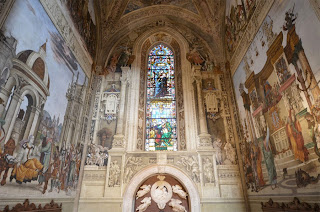The frescoes continually reminds us that pagan rituals are overcome by Christianity, including the war-god being destroyed and the dead being brought back to life. In the altar wall frescoes, Filippino Lippi abandons stories for allegories and symbolism. He blends paganism with Christianity even though they are antagonistic. He uses inscriptions and a "sombre grisaille" that replaces the colorism so vibrant on the side wall stories. (Sale) To understand the Strozzi Chapel in it's entirety, we must explore the meaning of the altar wall.
Filippo Strozzi was thought to have been a megalomaniac. This is most evident in an inscription in a frieze in the entablature at Lacceto. It reads, Virgini Gentrioi Philippus Strozza Sui In Salumtem Condidit. The Philippo Strozzi part is in much bolder letters and centered above for the viewers to see. What is at odds with this is that Philippo Strozzi is buried in the Strozzi chapel behind the altar. The marble of his sarcophagus in dark and the chapel is poorly lit. Strozzi's sarcophagus, with it's marble reliefs, and the arch above are not the altarpiece for the chapel but an element of the broader, decorative theme. Rising from the moulding, that goes around all three walls, is a very illusionistic architectural painting. It looks like marble and is intended to appear as if it is an extension of the tomb.
The heretofore hidden tomb now becomes monumental in it's appearance. It is based on the triumphal arch. The large, central arch contains the chapel's lancet window. There are figures, inscriptions, and decorative motifs. It was not uncommon in the late Quattrocento to have classical triumphal arches and the Renaissance was familiar with the literature describing them. Because of it's association with triumph and virtue, the function of the arch was a portal through which changes in one's existential status took place. The classical arch then became a feature of funerary architecture. Great wall tombs at that time included inscriptions. Sale, in his dissertation Lippi's Strozzi Chapel, states that this probably is the reason that Filippo Strozzi seny Filippino Lippi to Venice, as was stated in his contract. As you can see above, Filippino Lippi had the problem of fitting the High Gothic-shaped window within his classicized decoration. The chapel wall tomb's primary theme is that of immortality. Immortality with God is fundamental to Christianity. On the sarcophagus are reliefs of the Madonna and Child in a garland and cherub tondo. There are flying angels around. The sculpted part of the altar wall depicts the realm of dealth. The Madonna and Child show the promise of a future life. One of Filippo Strozzi's imprese is the recumbent lamb. We seen this in the keystone in the arch, symbolizing humility.
The spandrel area above the arch represents original sin. The ghostly beings on either side are standing on and holding skulls and bones. There are more skulls depicted. A plaque states Ni Hanc Despexeris Vives. The translates as Unless you scorn (despise) this, you will live. To scorn death is not Christian, it implies pride. "The redemption of Adam's sin by Christ did not remove the punishment of physical death but it opened the way to eternal beatitude for the Christian's soul and his resurrected, incorruptible body." (Sale) This implies that Christians should seek the liberation of the soul from the corruptible body. The two winged beings are not angels but, rather, personifications of death and sleep. They call our attention to this. The figure on the left gestures to an inscription to remind us of the ultimate decay of our flesh. This is not to sadden but to redirect the viewer's attention to the soul and the afterlife.
On the outer side of each column are inscriptions. On the right we see Deo. Max. (abbreviation for Deo Maximo) meaning to the greatest god. This refers to Mars.
On the left we see the inscription Parthenice which means virginal or virgin. Parthenice refers to the virgin goddess Diana who's iconography can be found in the Saint John the Evangelist miracle scene.
In both stories, paganism is defeated by Christianity. We see two female muses, one playing the lyre. They are in reversed poses. Their sweeping drapery obscures their physiques. Sale mentions that Winternitz, in his research, discovered the source of this on a sarcophagus with Apollo, Minerva, and the nine muses which is now in Vienna but was in Rome. The muse playing the lyre is in an exaggerated contrapposto pose. The muse on the right holds the mask of tragedy.






Very revealing study of the fullness of a unique Renaissance funerary chapel. While you assert the theme of the defeat of paganism, one really gets the impression of antiquity and its forms making a big comeback in Strozzi's chapel!
ReplyDelete